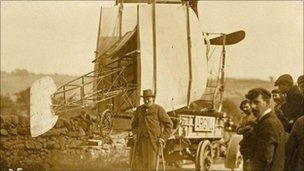Lanark's aviation history marked
- Published
Lanark's contribution to aviation history has been marked at a special event.
A memorial was unveiled at the town's racecourse to commemorate its role as Scotland's first airfield.
The ceremony coincides with the 100th anniversary of an international aviation meeting which attracted at least 200,000 spectators in 1910.
The memorial has been erected by a charity which aims to preserve former airfields as heritage sites.
The Airfields of Britain Conservation Trust (ABCT) said Lanark played an important role in early aviation.
Kenneth Bannerman, ABCT's founder, said: "This memorial is our way of recognising Lanark's place in aviation history and we hope it will add to efforts to ensure its significance is not forgotten.
"Indeed, this is the first of a number of memorials we plan to establish across Scotland to help celebrate these magnificent sites."
The town's racecourse played host to the Scottish international aviation meeting between 6 and 13 August, 1910.

The aviation meeting at Lanark attracted competitors from seven countries
The event, during which pilots from seven countries demonstrated their skills to onlookers below, proved highly popular.
At least 200,000 people are thought to have paid to attend over the course of the week, but the event still lost money.
The racecourse went on to see more flying activity, and early Scottish aviation pioneer WH Ewen later opened his flying school there in May 1911.
He made various flights but bad weather persuaded him to move his operation to the south of England the following autumn.
Later, there were occasional civil aircraft flying displays at Lanark during the 1920s and 1930s.
In the early summer of 1949 a licence for two grass landing strips at the racecourse was granted for light aircraft, but that only lasted for a few years.
Various requests in early 1958 for a civil or military airstrip at Lanark were refused.
Loganair was later recorded in March 1963 as pressing for Lanark to be regularly used for business aircraft.
The racecourse was closed in October 1977.